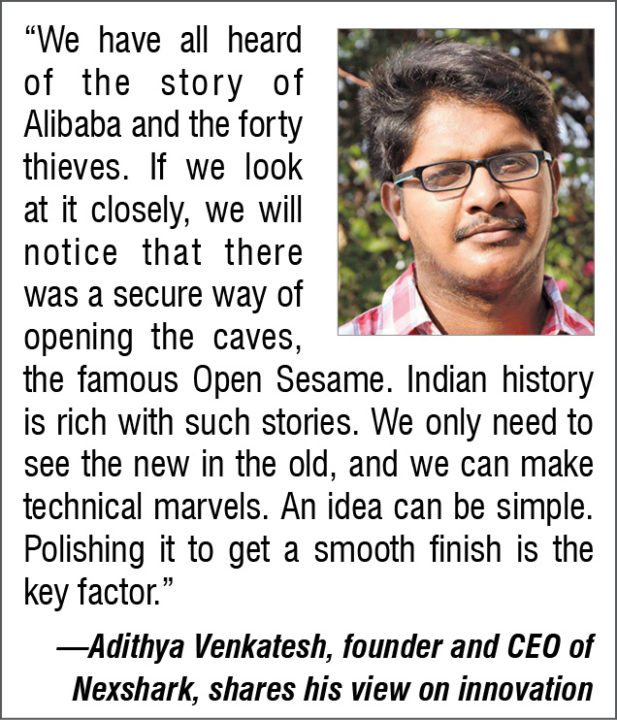Now is the age of online shopping and home delivery. In this context, we often hear stories about things not going the way they ought to. A customer replaced original products with dummy ones and returned those to a renowned online dealer, making huge profits. A person thrashed a company on social media for failed delivery, only to realise that the product had been claimed wrongly. Products get stolen during delivery, also exposing private information to unwanted eyes. These, while not everyday occurrences, are serious problems, especially for the vendor. But, the system is here to stay. What can then be done to ensure security of every delivery that is planned? Let us put together a smart packaging platform OpeKun, says the team from Nexshark, emphasising the importance of vendor-customer handshake.
Say Hi to OpeKun
Adithya Venkatesh, founder and CEO of Nexshark, and his team consisting of Sivakumar, Nitin Kumar, Uma Sankar and Prakash, went about designing an innovative platform to link e-commerce vendors and end users in an electromechanical way, to ensure safe delivery of packages.
In e-commerce delivery, there is no authentication or authorisation between the consumer and the retailer. Named OpeKun, this solution makes use of Bluetooth Low Energy capabilities and uses strong encryption methods to acknowledge safe receipt of parcels.

How it works
The idea is to create a strong handshake between the vendor and the customer. Package boxes are designed with a combination of electronic and mechanical methods.
Basic principles like operation of levers, pulleys and gears, 3D printing, mobile computing and Bluetooth connectivity have been exploited to arrive at this comprehensive low-power solution. Each package of OpeKun has a microcontroller with miniaturised semiconductors for reduced size and a lock that is connected to the Cloud; the entire process is encrypted by asymmetric keys.
When a parcel is dispatched, a public key is programmed into the microcontroller inside the OpeKun package. At the same time, a private key is securely delivered to the customer on the app. The public key is embedded in iBeacon format and transmitted; though everyone can see it, it is ineffective unless combined with the private key.
Once the parcel arrives, the customer gets the public key from the Bluetooth-enabled packet and uses the private key to unlock the parcel. If the parcel has been tampered with at any point of time, the customer, on connecting to the Bluetooth portal, receives a warning message, instead of the usual unlock option.
Security is always a challenge
OpeKun took almost a year to take shape from when the idea was conceived. The main challenge was in identification and collaboration, as these require a high level of expertise. What worked for it was combined work by members skilled in different domains.
While there are many smartlockers readily available in the market, in most, the locking systems are attached to doors and, predominantly, use solenoid valves. The solution offered in this product is different, owing to the electromechanical combination put together to specifically address logistics problems on the wheels.
A theft that laid the groundwork
How often have you heard of someone being inspired by a movie or a TV serial, and go on to achieve something huge? Well, here is a case of something similar!
Fig. 2 shows a freight train and a well-secured container with methylamine. Still, calculative minds managed to pull off a heist of a kind, without anyone even realising it. This is a scene from the popular American TV serial Breaking Bad, which started it all for Nexshark. It got the makers thinking of how vulnerable the numerous tankers carrying petrol, oil and even water are, which travel around the country on a daily basis.

The team then came up with a hack-proof smartlock combining mechanical and embedded electronics. If implemented in the right manner, this could even solve problems like supplying low-quality products to farmers or safeguarding bundles of exam papers.
The thoughts—huge and costly
It is only natural to think of what such a solution would truly mean to a vendor. Would the implementation escalate budget costs? Can the delivery agent carry the required number of boxes? The developers plan on providing this solution as a service, meaning that, the cost to the vendor would be a minimal amount for just the transaction.
To make it easy on the person delivering the packet, the developers are looking at using lightweight polyvinyl chloride (PVC) as packaging material. As every box is re-usable, the target is to make boxes of standard sizes that can fit most regularly-bought high-end products and transport these safely.
Unlocking the next steps
The team has its plans in place. Having won Makethon organised by IESA and Intel, it is in the process of patenting this stroke of genius.
Thinking beyond the e-commerce industry, the developers are working with pharmaceutical companies to create package containers that auto-lock when the stock reaches its expiry date.
 Another area being looked at is an alternate mode of locking for transport vehicles carrying milk, petrol and water.
Another area being looked at is an alternate mode of locking for transport vehicles carrying milk, petrol and water.
There are also advanced versions of the platform being planned, which would include support for global positioning system (GPS) tracking and measurement of abnormal conditions during transit like shock, impact, temperatures exposed to and the like, using built-in sensors. As one might want to provide authorisation access to a friend/family member, the team is also working on a key sharing setup that would enable transfer of the private key by the customer.
With quality and quantity taking a hit in these uncertain times, the world is looking forward to more such solutions that could help carve out more organised systems. Good luck, team Nexshark!
For more innovation articles: click here
Priya Ravindran was working as a technical journalist at EFY until recently









sir, i want to know the whole process of safe secure delivery. please help me.
Kindly elaborate your query please.